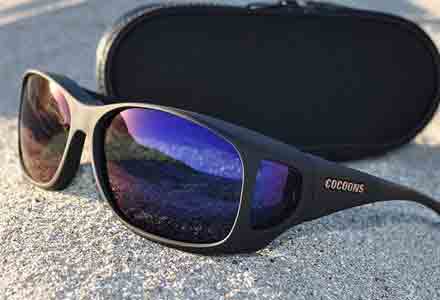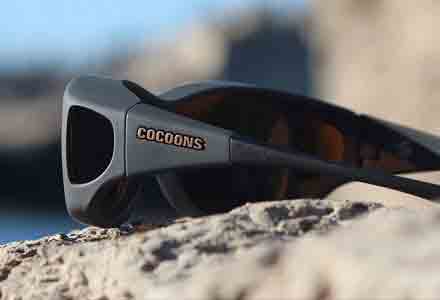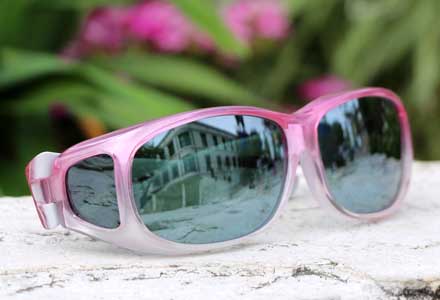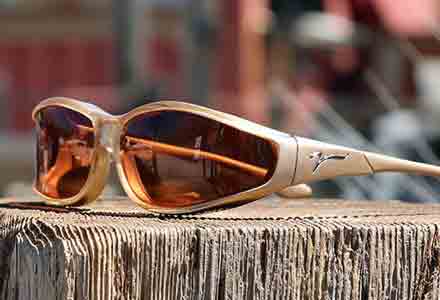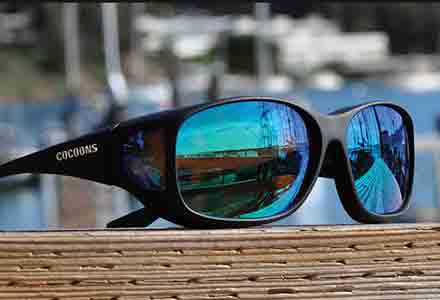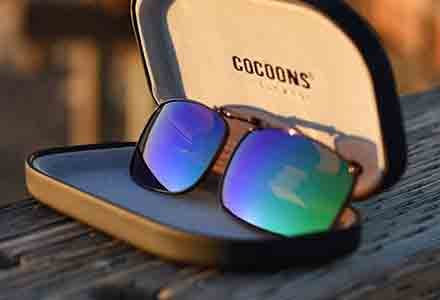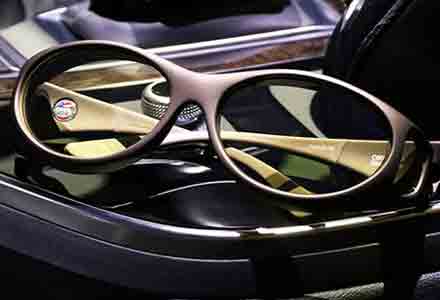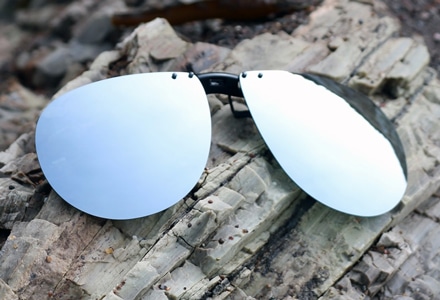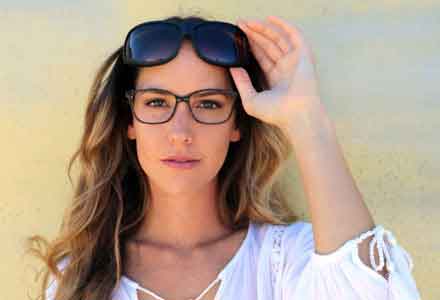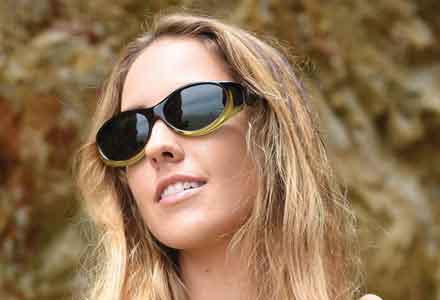UV & Eye Health
UV & Eye Health
How does sunlight damage your eyes?
The sun is far and away the strongest source of ultraviolet (UV) radiation for Earth. Over exposure to ultraviolet rays can damage the eyes in a similar way as it does the skin: it can cause cancer of the eyes and eyelids, increase the likelihood of cataract formation, and sunburn your eyes. Exposure to UV radiation can immediately weaken vision and, over time, cause irreparable damage to the eyes and eyesight.
What are the different types of UV radiation?
There are three types of UV radiation: A, B, and C. They differ in wavelength as well as biological effects. The following information on each comes from the World Health Organization:
-
- UVC has the shortest wavelength and is the most dangerous and biologically active. Fortunately, UVC is completely filtered by the atmosphere and does not reach the Earth’s surface.
- Medium-wavelength UVB is very biologically active, but it can’t penetrate past superficial skin layers; it can, however, cause tanning and burning. While most UVB is filtered by the atmosphere, research has found that it significantly promotes the development of skin cancers.
- UVA makes up close to 95% of the UV radiation reaching the Earth’s surface. It can penetrate deep into the skin and is also responsible for tanning and burning. Recent studies suggest that UVA can also promote the development of skin cancers.
Can reflected sunlight potentially harm your eyes?
According to the Vision Council, reflected UV radiation is just as damaging as direct UV. Water reflects up to 100% UV radiation, snow reflects up to 85%, sand and concrete reflect up to 25%, and grass reflects up to 3%. When doing activities in these environments, it is important to wear sunglasses and sunscreen.
What are the peak hours of UV radiation?
UV radiation is strongest when the sun is at its most intense, between 10 AM and 3 PM. However, research indicates that the eye absorbs almost twice as much radiation during peak times for outdoor activities, which tend to be in the early morning (from 8 AM to 10 AM) and in the late afternoon (from 2 PM to 4 PM).
Can UV damage eyes when it’s cold or cloudy?
Temperature has no bearing on UV radiation; UV is always present, and our eyes are always at risk of exposure. While a cloudless sky will generally foster more UV intensity, only around half of all UV radiation reaching your eyes comes directly from the sun. According to the Vision Council, the other half reaches your eyes after being transmitted through clouds and reflected off surfaces like streets, buildings, water, snow, and sand.
How do Cocoons help preserve your eye health?
Cocoons are engineered to provide maximum protection from the elements. Our polarised Polaré lens systems block 100% of UV radiation, and Cocoons frames include an integrated protective brow bar and undercarriage, shielding your eyes from all angles. It’s important to make sure that any sunglass you buy provides 100% UV protection. Even if it has a sticker that says something like BLOCKS UV, it may not shield your eyes completely from both UVA and UVB radiation.
What defines good blue light vs. bad blue light?
Blue light is sometimes misunderstood, but what is clearly understood by the optical industry is that there is a line between good blue light and bad blue light. As put by one optical professional in an American Optometric Association article on blue light, “We don’t know yet where bad blue light ends and good blue light begins…” That said, there are some basic theories that most professionals agree on. Most agree that everyone needs a certain amount of blue light – the good blue light. This is the light that helps your body’s natural sleep cycle, increases alertness, and can also help with your memory and mood so it is important to not completely eliminate it.
Blue light is not just one colour but instead is infinite. Light is measured in a range of wavelengths, just like radio waves or television signals. On one end of the range is the ultraviolet (UV) light. Everyone knows that UV light is bad for the eyes, so it is important that your sunglasses block 100% of these wavelengths. On the other end of the range is the infrared light often associated with television (and other) remote controls. As people, we can only see the light between the UV and infrared light. This is called the visible spectrum (and not all of us can even see that). Scientifically, the visible light wavelengths range from 380 to 800 nanometers(nm). The lower the number on the range, the shorter the wavelength of the light and the more energy the light carries with it. Blue light is at the lower end of this visible spectrum with wavelengths ranging between 400 and 500nm.
Focusing on the blue light range alone, on the low end is the blue-violet light which combines blue light with the really bad UV light. This is generally understood to be the bad blue light. Some sources say the worst blue light exists in the 411-420nm range. As you move to the longer blue wavelengths, the light becomes blue-turquoise in colour. This is the good blue light.
According to a 2014 article published in the Review of Optometry, “The labeled blue-turquoise light range, which is from 465nm to 495nm, is essential to our vision, the function of our pupillary reflex, and in general to human health.” Ultimately, “this blue-turquoise light really plays a vital role in the general health of the individual.” Based on this and other research, it is important to have some blue light exposure. For additional information and guidance concerning blue light exposure, it is recommended that you visit your local eye care professional.
Lens Info
How does polarisation work?
Normally, light waves move randomly in an infinite number of directions; however, when light reflects off a smooth surface (e.g.: water, road, car window, snow), it moves more uniformly, intensifying and “polarising” into reflective glare. Polarised lenses contain a special film between two layers of lens material designed to absorb the polarised waves before they reach your eyes. The film is made of iodine crystals that are positioned in vertical rows. When properly positioned, the polarisation film blocks glare, transmitting only usable light. Non-polarised sunglasses reduce visible light; however, they have little or no effect on reflected glare. Only properly aligned polarised lenses eliminate glare and help you see more clearly.
Are Cocoons polarised?
All Cocoons fitover sunglasses feature our Polaré polarised lens systems, which deliver maximum polarisation efficiency to keep eyes relaxed and focused by reducing glare much more effectively than a non-polarised lens. However, under extreme low light conditions (such as night time), or when used indoors or in conjunction with certain types of LCD or LED screens, polarised lenses may be too dark and hinder visibility. For these unique situations we offer specialty lenses, like our Twilight Night Drivers and Low Vision UV filters, that are not polarised, but feature unique filtering properties that can help.
Which lens tint is best for me?
Choosing the best tint depends on what you’ll be using your Cocoons for. All Polaré lenses block 100% of UV radiation, but different lens tints filter types of light differently. If you’ll be in bright daylight, for example, you’ll want a lens that doesn’t let a lot of light in, like a dark gray lens or a mirrored lens. In less intense sun or varying light conditions, however, you’ll want a more moderate lens, like an amber, copper, or yellow–something that sharpens object definition. To find out more about tints that will suit your individual needs best, visit our Polaré Lens page.
Can I wear my Cocoons over transition lenses?
Yes. Many people wear Cocoons with their transition lenses for the benefits of more UV protection, polarisation, different lens tints. Transition lenses only activate when they come into contact with UV radiation, and since Cocoons shield your eyes from 100% of UV radiation, your prescription transition lenses will simply not darken.
Can I wear Twilight lenses during the day?
While Twilight lenses are indeed anti-reflective and 100% UV protective, they feature technology that allows for maximum light transmission, as they are intended for nighttime and low-light use. This means that they won’t necessarily cut down that much on brightness. For daytime use in low-light conditions, we recommend using something like our polarised yellow lens, which improves object recognition and gives a sense of heightened visual acuity.
Are Cocoons okay for use on a motorcycle?
Cocoons are ideal for motorcycle use. Many motorcyclists prefer Cocoons not only for their unparalleled UV protection, but also for their ability to shield the eyes from wind while not being quite as bulky as a goggle. The patented frame designs feature an integrated brow bar, undercarriage, and peripheral side shields, totally protecting the eyes from wind and road debris. Moreover, Cocoons’ adjustable Flex2Fit temples provide a secure and customizable fit when worn in conjunction with a helmet.
Cocoons Features
What features should I look for in a fitover?
The ideal fitover will offer you complete protection from all angles, extended wear comfort, and an unimpeded range of vision. Don’t settle for anything less than 100% UVA & UVB protection. To ensure all-around protection, the frames should feature an integrated brow bar and underside returns, as well as full side protection. Too often, people complain of their fitovers being too heavy or ill-shaped for their prescription frames and face shape. Cocoons feature a lightweight frame that is also extremely durable. Most fitover brands feature a standard temple that can pinch or be too lose and allow the frames to slide forward. Our patented designs incorporate the Flex2Fit adjustable temple system that allows you to manually contour the shape of the temples for a snug fit that is free of excess pressure. Adequate peripheral vision is a must. Some fitover manufacturers will neglect to include side shields in their frames, which poses risks to wearers and those around them. With our ultra-protective Polaré lenses, comfortable Flex2Fit temples, and unique range of fitover sizes, we’re committed to providing you with the best fitovers you’ll ever wear.
How can I find the right size for my eyewear?
Cocoons fitovers are available in a wide range of sizes and shapes designed to be worn over glasses. We recommend using our Cocoons Size Finder to determine the best size to fit over your glasses. In order to use the size finder, first you’ll need to measure the full width and height of your eyewear frames in millimeters, then you’ll be ready to calculate your recommended size.
Do Cocoons come in children’s sizes?
The Cocoons collection does not include models that are specifically designed in children’s sizes, but we do offer two frame sizes that cater to smaller faces and more petite prescription eyewear styles. Please see the Cocoons Stream Line (S) and Mini Slim (MS) sizes for available options.
How durable are Cocoons fitover sunglasses?
Extremely durable—in fact, they’re virtually indestructible under normal wear. To demonstrate just how durable they are, we ran them over with a car to prove it. Cocoons frames are manufactured from ballistic nylon so durable you can twist the frame inside out and it will pop back into shape with no signs of deformity. Our proprietary Polaré lenses are scratch-resistant and extremely strong (8X stronger than most competitors’ lenses). Find out how Polaré lenses outperform standard lenses.
What sets Cocoons apart from other fitovers?
Cocoons are engineered with both comfort and unparalled UV protection as the primary focus. Our patented designs feature lightweight, yet durable frames that are available in a full range of sizes to provide a near tailored fit when worn over most styles of prescription glasses. The majority of fitover brands use inferior quality, low-grade lenses. We believe it is paramount that when wearing Cocoons over your prescription glasses that the fitover lenses must be optical-grade and crystal clear to avoid any distortion that could reduce the acuity of your corrected vision. When purchasing Cocoons, you’re not just getting the world’s finest fitovers; you also have access to some of the best customer service in the industry. Please feel free to contact us with any questions or concerns you may have at connect@cocoons.uk.
How do I adjust my Cocoons temples?
Cocoons’ signature Flex2Fit adjustable temples ensure a custom fit that will keep your eyewear secure while avoiding the unnecessary pinching or pressure often encountered with standard temples. Adjusting and shaping the temples for a precise fit is very easy and does not require any special tools or heat. Simply apply the necessary pressure to bend and shape the contour of the temples until they provide the perfect custom fit for you. Please see our video for visual demonstration.
Warranty & Services
How can I find a stockist near me?
Cocoons are sold in numerous optical shops around the world. To find your nearest authorised stockist, visit our Store Locator. If your initial search doesn’t provide a list of locations, try expanding your search radius. If you live outside the United Kingdom, please use our International Stockist Locator
What accessories come with my Cocoons?
All Cocoons come with a custom designed Cocoons case and an Ultra Soft Lens Cloth. For additional accessories including lanyards and jumbo cleaning towels check out our Accessories Shop.
What post-purchase services am I entitled to?
With your purchase, you have exclusive access to our industry-leading warranty as well as our unparalleled customer service. We’ve been heralded time and time again for our tireless dedication to ensuring that each and every Cocoons wearer is 100% satisfied with their Cocoons experience. If you encounter any problems or concerns, we’re here to help. Please reach out to us at connect@cocoons.uk for immediate assistance.
How can I tell if my Cocoons are genuine?
If you bought your Cocoons from an authorised stockist, you have nothing to worry about—your Cocoons are genuine, and you’re entitled to all of the benefits of owning them. We strictly regulate the online and brick-and-mortar vendors who can stock Cocoons, and we encourage you to contact us if you have any questions or concerns regarding whether your vendor of choice is authorised or not.
What is your return/exchange policy?
We offer an exclusive 14-day money-back guarantee. If you don’t completely love your Cocoons, just send them back and we’ll refund you. If you discover that you’ve ordered the wrong size and would like to exchange your order for a new size, please contact us at connect@cocoons.uk and we’ll be glad to help.
What are the details of your warranty?
We are very proud of the durability and quality of Cocoons. Thus, we warrant all defects in material and workmanship to the original purchaser for life. All products will be replaced or repaired at the discretion of Cocoons. Determination of warranty status is made solely by Cocoons. Repairs will be made by Cocoons, as no one else is authorised to make repairs. Unauthorised repair attempts will void all warranty claims. You can learn more, register your warranty, or file a claim for a replacement or repair by clicking here.

